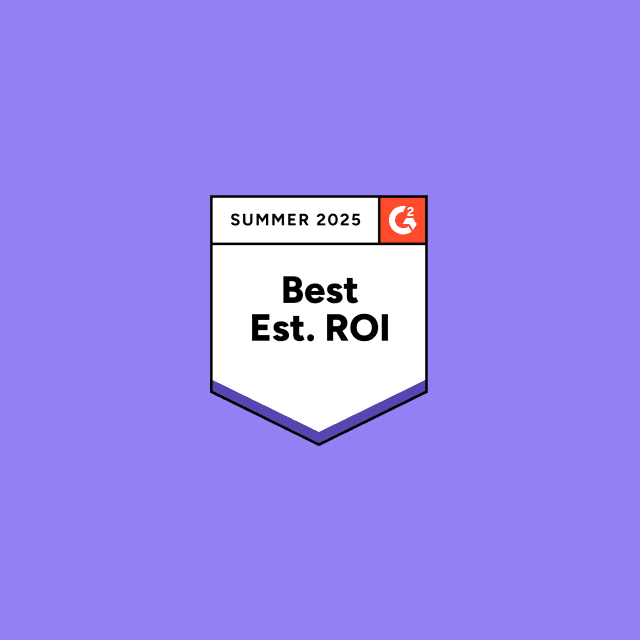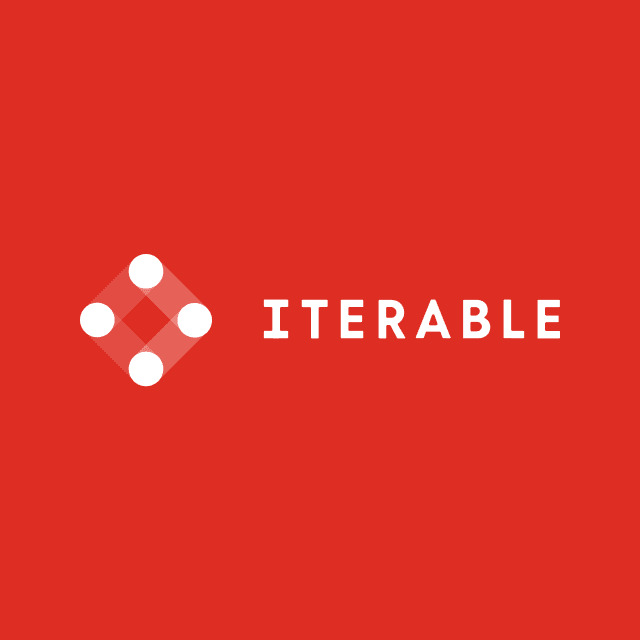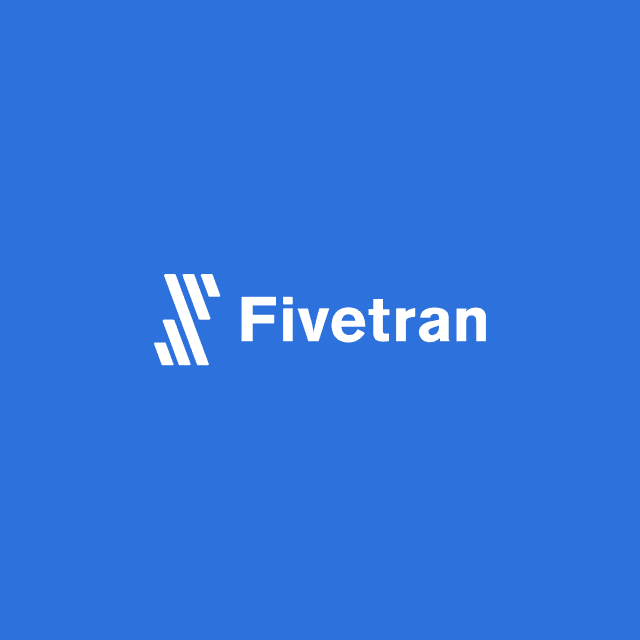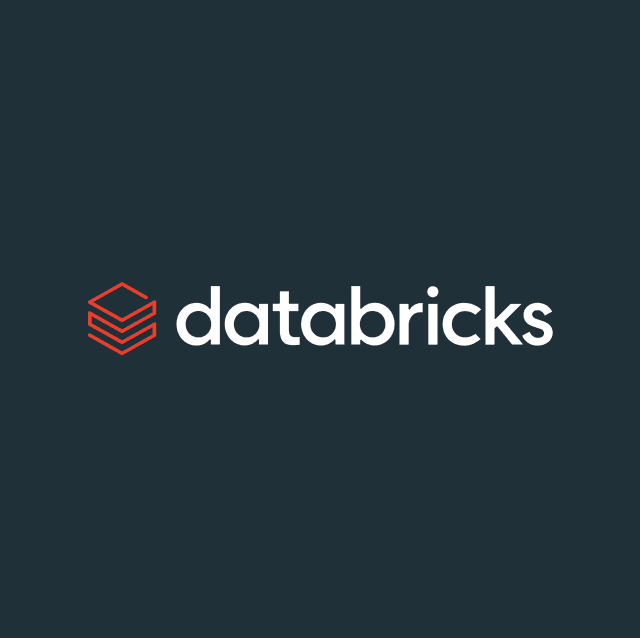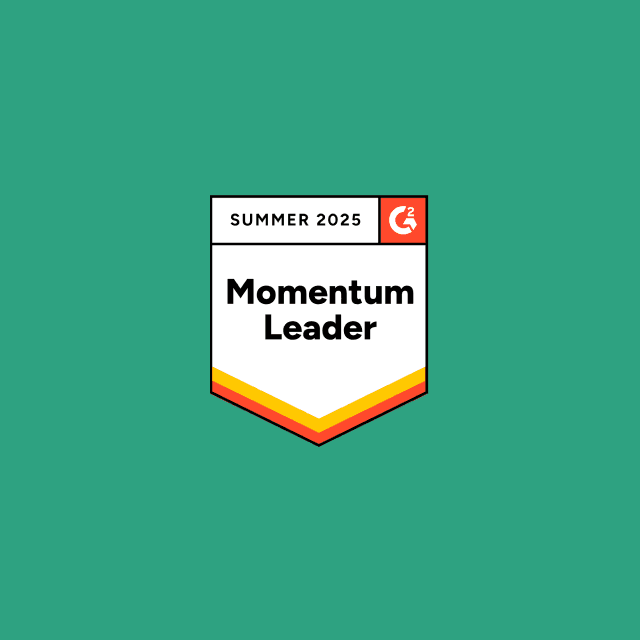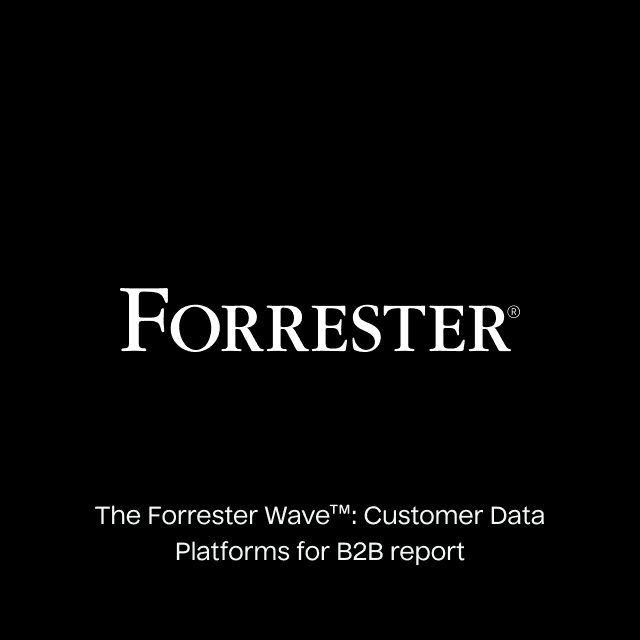Introduction
In January of 2016, after being a loving customer for years, I decided to join Segment, a leading Customer Data Platform (CDP), as one of their first ten engineers. The vision made immediate sense to me: to build a central platform for organizations to collect, synthesize, and activate their customer data. Marketing teams would finally be able to activate their data freely to personalize campaigns across all their channel tools and ad networks.
The broader market at the time was just as bought in as I was. CDPs quickly rose in popularity as organizations invested in empowering their marketing teams with actionable customer data. Executives threw CDP implementations to the top of their priority lists and dedicated hundreds of thousands - if not millions - of their marketing budgets, as well as teams of engineers, to implement them. Regardless of the high costs and long implementation phases, they knew the importance of providing marketers with actionable first-party data.
It was hard to imagine that we could have been building it all wrong.
What is a CDP, and why were they exciting?
A Customer Data Platform (CDP) is an all-in-one data platform built for marketing teams. They serve as a database for all your customer data with a bundled activation layer to help you leverage your data for marketing automation.
That’s what made them special; at the time, we thought that CDPs could not only centralize all customer data into a “360 view”, but also make it easy for marketers to take action on that data.
All CDPs have at least three core components:
-
Data Collection: Since CDPs are a database of customer data, they need to give you a way to send data to them. To solve this, CDPs expose an API for developers to track user traits and events (e.g., the actions users take across websites and mobile applications.)
-
Data Transformation: CDPs usually have an out-of-the-box identity stitching functionality and tools to create custom traits on user profiles.
-
Data Activation: CDPs are useless unless they help you act on your data, so they have integrations enabling you to sync enriched profiles and audience segments to marketing channels.
In a legacy CDP, all of these features are bundled together in a tightly integrated all-in-one solution that allows marketing teams to centralize customer data directly inside the CDP.
What I missed at the time–what we all missed–was the rise of the cloud data warehouse and what that meant for managing and activating customer data.
Cloud data warehouses make legacy CDPs obsolete
During my time at Segment, of all the technologies in the data space, perhaps the only one growing faster than CDPs was cloud data warehouses. Thanks to the breakthroughs of market leaders like Snowflake, BigQuery, Databricks, and to some extent, Amazon (Redshift), data teams can store, model, and analyze their customer data faster and more efficiently than ever before.
Once only available to enterprises with enormous budgets and large dedicated data engineering teams, data warehouses became accessible to organizations of every size. In a few short years, they became ubiquitous.
Data teams quickly spun up enterprise-grade data infrastructure that provided entire organizations with a source of truth for their customer data. These were made even more useful by a rapidly-evolving ecosystem of tools, including dbt. These new warehouses would house ALL of an organization’s customer data from any source - rather than just their interaction events captured in their CDP. The adoption of the warehouse spread fast and the gravity of data within companies shifted to the data warehouse.

Traditional CDPs operate in a separate data silo from the Data Warehouse.
Suddenly, the “sources of truth” within organizations began to collide. Marketing’s CDP-based “truth” became increasingly incomplete and misaligned with the truth as defined by analysts in the data warehouse. Our customers began to wake up - two years and a couple hundred thousand dollars later with a CDP that didn’t have all the data they needed and a dozen meetings on their calendars titled “metrics reconciliation.”
This was not the dream we had promised.
The rise of data activation
That brings us to 2019. CDPs were inaccurate, incomplete, and expensive - but they were actionable. The warehouse was accurate and comparatively cheap–but the data was stuck inside.
That exact gap (warehouse activation) ultimately led my co-founders and me to leave Segment in 2019. We took our experience building CDPs and decided to create Hightouch–a Data Activation platform. Hightouch unlocks the true value of the warehouse, syncing data to hundreds of business tools. We first built our Reverse ETL technology to empower data teams and technical users to sync data from the warehouse using SQL. We then democratized this power to marketers, advertisers, and other non-technical business users with Customer Studio, a suite of no-code tools to build audiences and sync them to everyday tools.

Hightouch syncs data from the warehouse to downstream tools.
Data Activation laid the foundation of a new Composable CDP architecture that centers on the data warehouse as the hub of customer data–eliminating the data silos created by now-redundant CDPs.
CDPs are dead
At the beginning of 2022, with validation from multiple Fortune 500 customers, our team here at Hightouch made a bold prediction: Customer Data Platforms are dead. We asserted our core beliefs about CDPs: the goal of empowering marketers with actionable customer data in their daily tools is correct, but the traditional CDP architecture is fundamentally flawed because it operates as a separate silo from the data warehouse.
Now, the market has shifted around our disruptive warehouse-first paradigm. To survive, most traditional CDPs have tacked on lightweight Reverse ETL features to activate some warehouse data, but they still remain fundamentally dependent on a separate data silo in their all-in-one packaged platform. Many of these traditional CDPs are co-opting “Composable” as a buzzword without building a truly unbundled, modular, flexible, and warehouse-native platform. In the meantime, the Composable CDP has become a mainstream concept that marketers demand, and true Composable CDPs like Hightouch are rapidly growing.
Traditional CDP vs. Composable CDP
See how the two approaches compare across speed, compliance, cost, and scale—all in one chart.


The Composable CDP
Companies use Hightouch to create a Composable CDP centered on their data warehouse, such as Snowflake, Databricks, Google BigQuery, and Amazon Redshift. The Composable CDP accomplishes every function of traditional CDPs, including event tracking, identity resolution, and Data Activation. At the same time, the Composable architecture means that companies can use their existing infrastructure or preferred providers for any part of the CDP stack and only add the features they need.
Here’s how you could compose a CDP on your warehouse of choice, using Hightouch’s complete solutions (that could just as easily be swapped out for other Composable vendors as needed):
Data collection
- Event Collection: CDPs provide SDKs so you can track customer activity on your websites and apps. Hightouch Events collects and stores digital events directly into your data warehouse.
- Event Streaming: CDPs allow you to stream events directly to downstream tools to power real-time use cases. Our Event Streaming feature now enables you to power these same use cases when you need to bypass the data warehouse.
Data transformation
- Identity Resolution: CDPs merge all the customer data you collect into unified 360° profiles. Hightouch’s Customer 360 Toolkit lets you do this for users and any other entities like households directly in your data warehouse.
Data activation
- Syncing Data to Tools: While traditional CDPs sync data directly from their own data store to marketing tools, Reverse ETL lets you do this from the data warehouse.
- Build Audiences: In CDPs, marketers segment users and choose which data they sync to their tools. Hightouch built our Customer Studio to let marketers build audiences, coordinate campaigns, run tests, and analyze results within the warehouse.
- Data Onboarding: Advertisers typically use platforms like LiveRamp to enrich their data with identifiers to boost match rates in ad platforms. Hightouch built Match Booster to enrich data in-flight from the warehouse to ad platforms, removing this extra step.
- Personalization: Some CDPs support real-time onsite personalization. Hightouch offers a low latency Personalization API to fetch data from the warehouse and power personalized experiences.

Hightouch offers a complete and Composable CDP
Realistically, most organizations already have significant portions of this architecture in place from home-built solutions or already implemented vendors. Creating a Composable CDP is often as easy as adding features for the missing parts of your tech stack that will allow you to collect, unify, and then activate customer data from the data warehouse. Said another way: your Composable CDP may include all of Hightouch’s products, or just the ones your company needs in tandem with your other preferred vendors or homegrown solutions.
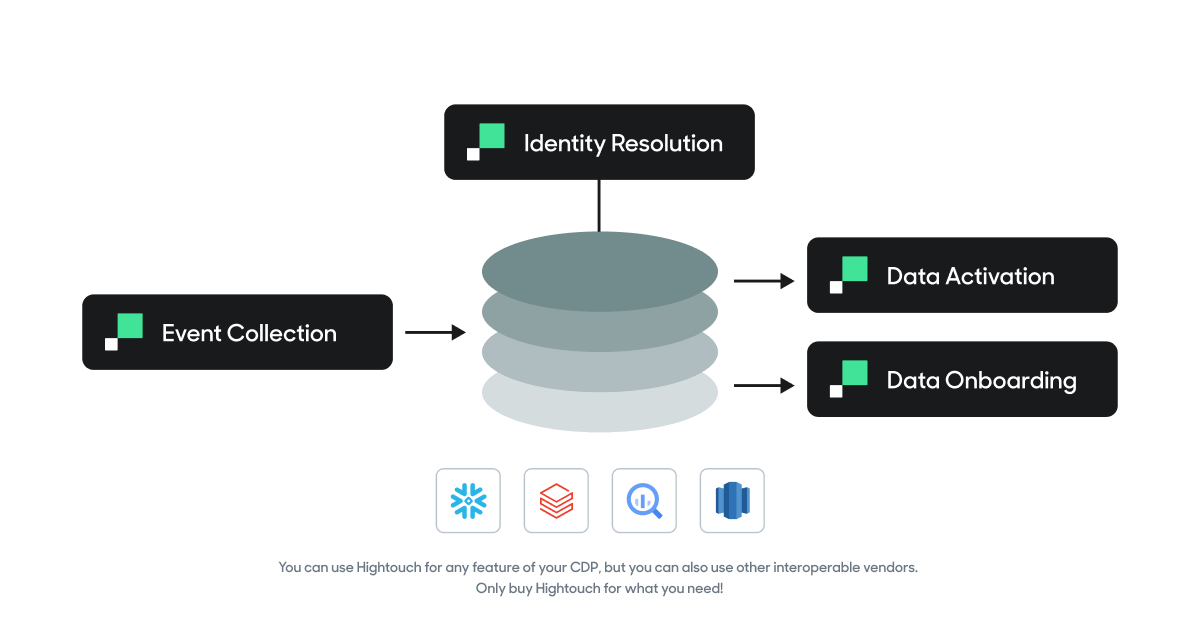
You can use Hightouch for any feature of your CDP, but you can also use other interoperable vendors. Only buy Hightouch for what you need!
Why composable is the future
The Composable CDP is taking off because it offers several essential benefits against traditional CDPs:
360 degree view of customers
While legacy CDPs claim to provide a single source of truth for data, the reality is they only consolidate a fragmented copy of customer data. Because the Composable CDP operates from the data warehouse, organizations can activate all of their customer data– not just the clickstream events captured in off-the-shelf CDPs. The Composable CDP lets companies leverage data from sources like POS systems, data science models, and offline data to create and act upon a true Customer 360.
Furthermore, the data warehouse can model data based on whatever entities an organization cares about. Companies track unique entities like households, the number of pets each customer owns, distinct insurance policies assigned to each customer, and countless others. Traditional CDPs rely on rigid user and event data models, and so the customer data they collect and act upon doesn’t neatly incorporate these other entities. The warehouse, and therefore the Composable CDP, can easily link associated entities to each other and to each customer.
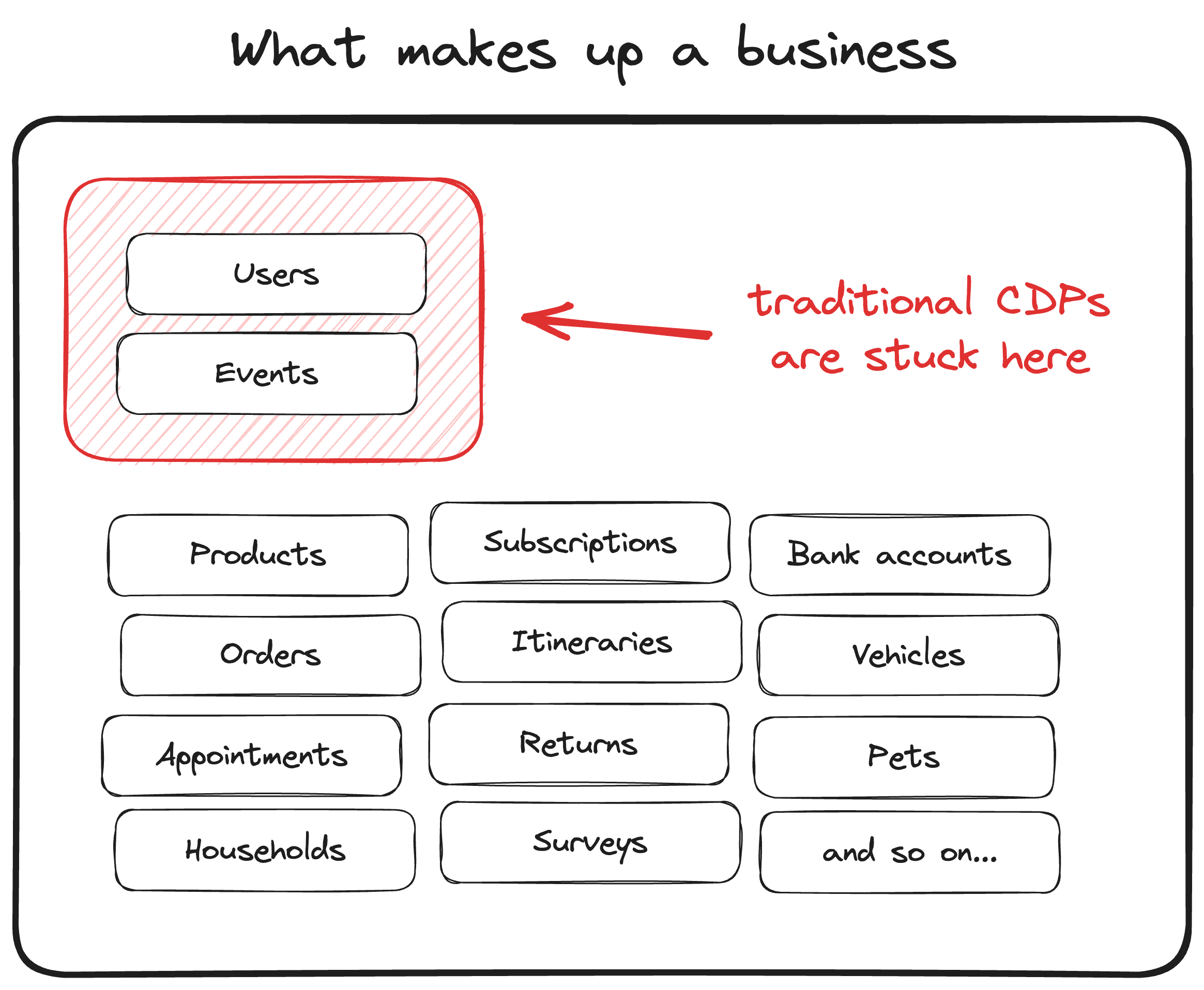
Traditional CDPs don't ingest all customer data. The data warehouse can.
Time to value
Traditional CDPs are massive monolithic platforms, and they take months to implement. In contrast, the Composable CDP starts with your existing data infrastructure and is modular, so it’s easy to add features or new tools as needed. If you have uses for your existing data that you want to act on, you can begin syncing data from your data warehouse to your tools immediately. That is a literal impossibility with the months-long implementation that comes with a traditional CDP.
Market-leading features
From the beginning, we built Hightouch to work with the data warehouse, with both data engineers and non-technical business users in mind. While traditional CDPs work through years of tech debt and re-engineering to try to adapt to the data warehouse, we’ve always been focused on providing best-in-class features to power audience building, cross-channel experimentation, and more.
We’re also leveraging the data warehouse to accomplish goals that traditional CDPs never could. For example, we built Match Booster to enrich first-party data as it syncs to ad platforms like Facebook, which boosts match rates and, therefore, return on ad spend (ROAS). This essentially allows the Composable CDP to also accomplish data onboarding, helping our customers avoid wildly expensive contracts with providers like Liveramp as well.

Hightouch's Match Booster enriches data in-flight to ad platforms to improve match rates.
While Hightouch offers features for every component of the CDP around your data warehouse, the Composable CDP is modular by design. If you have existing or preferred vendors for any of your CDP functions, you can and should use those– that’s the beauty of the Composable architecture.
Security and governance
Whenever you add a tool that replicates and stores data, like traditional CDPs do, you create a new avenue for a security breach. The Composable CDP does not store your customer data: it remains in your data warehouse. While most traditional CDPs struggle to become HIPAA-compliant or data-residency compliant even after years of trying, for Composable CDPs, compliance is a breeze because the data is secured and tightly governed in your warehouse.

The Composable CDP is the best option for customer data security
Best-in-Class Governance Features
Download this whitepaper to discover Hightouch's enterprise-grade governance features that empower businesses of all sizes, including Petsmart, Accor, AXS, and more, to securely manage data activation at any scale. Take control of your data management and revolutionize your business with Hightouch.


Affordability
Traditional CDPs are outrageously expensive. They are bundled solutions, so you must pay for all of their features, even if you already have viable solutions in place for parts of their offerings like identity resolution. Furthermore, data storage isn’t free. The redundant data storage that CDPs introduce in their own silo results in higher costs that get passed back to you, the CDP buyer. Finally, traditional CDPs require expensive monthslong implementations and further billable hours for re-implementation as your data needs evolve.
The Composable CDP allows you to leverage whatever infrastructure you already have in place, like your data warehouse. You only need to add features that you need for your use cases in this unbundled architecture. By its very nature, the architecture of a Composable CDP therefore enables companies to accomplish their goals at significantly lower costs.
The road ahead
As the Composable CDP gains traction, we’ve seen several major CDP players develop reverse ETL capabilities to stay relevant. We fully expect all CDPs (and even some marketing platforms, like ESPs and CRMs) to eventually embrace the data warehouse as their source of truth, further validating our approach from the beginning. Hightouch is and always has been purpose-built for the warehouse. Modular components being tacked onto existing CDPs and other martech may sound nice, but at the end of the day will run back into the same architectural limitations that landed them where they are today.
Ultimately, when you evaluate a CDP, take a hard look at its offerings. Regardless of marketing buzzwords, if it doesn’t run on your data infrastructure or it comes as a bundled all-in-one solution: it’s part of a legacy technology that’s been outclassed.
At the end of the day, our team–stacked with years of experience building and buying leading CDPs–has landed on one similar conclusion: Friends Don’t Let Friends Buy a CDP.
If you’re interested in exploring Hightouch’s products as you compose your own CDP, reach out to our solutions engineers for a demo. If you’re ever interested in nerding out about the data or marketing technology space, shoot me a note at tejas@hightouch.com.










